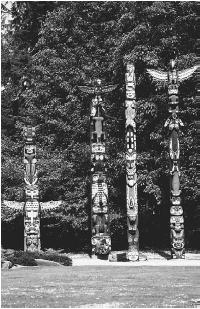Tribal Empowerment
Totems
Among the shamanic teachings of the traditional Native Americans, the totem represents the physical form of one's spirit helper, his or her guardian or guide. The totem entity may in some ways be comparable to the concept of a guardian angel or spirit guide that presents itself on the physical plane in the form of an animal.
Traditional Native Americans believed that the great mystery prepared the land as a place where all things that swam, walked, crawled, and flew were to mingle in harmony. Gifts were bestowed upon each creature, with abilities to learn lessons from one another. The native people accepted their kinship with all of nature and believed that each entity performed its specific talents according to its abilities. Therefore, it was advantageous for all humans to learn the identity of their totem and to receive its lessons in order to make their lives more complete.
In the shamanistic tradition, all creatures are called relatives and are considered brothers, sisters, parents, and so forth. All nonhuman entities are regarded as "people," and everyone has an important role to perform in the larger system of life.
It was the totem animal that guided shamans through the portal that led to the other world, to the mysterious transcendent reality beyond the material world, the dimension that lay beyond time and space. For all the members of the tribes, their own totem animal gave them their spiritual power and provided them with their own instrument of passage into the spirit world. Their totem animal would guide them in the purification of their spirit, helping them to achieve self-discipline through fasting, prayer, and the emptying of their hearts of all earthly desires. Although many in the Judeo-Christian tradition prefer to emphasize the charge that humans shall have dominion over all animals, it might be mindful to also take serious notice of Job 12:7–8: "Ask the animals, and they will teach you, or the birds of the air, and they will tell you; or to speak to the earth, and it will teach you, or let the fish of the sea inform you."
Although totems are most often associated with Native Americans, many cultures have at some time in their past used animal totems. Local sport teams use names such as the Tigers, Lions, Bears, Cardinals, and Falcons. Various religions and sects use expressions like the Lamb of God, the Dove of the Holy Spirit, and the Lion of Judah. People through history have even had such surnames as Bear, Beaver, Wolf, Crane, Crow, Drake, Finch, Fish, Fox, Hawk, Robin, Pike, Lamb, Partridge, and Salmon.
For many centuries, humans have allowed animals to be both surrogates and teachers. The ethnologist Ivar Lissner has pondered the provocative mystery of why those anonymous Franco-Cantabrian cave artists of more than 20,000 years ago never left mankind any clearly defined self-portraits that would show the exact physical appearance of human ancestors. Aside from a few Venus-type mother-goddess statuettes, people are left with a rather bizarre collection of ghostly creatures with the heads of animals and birds, strange half-human, and half-animal entities.
Lissner suggested that the Stone-Age artists really were portraying themselves, "…but in the guise of intermediary beings who were stronger than common men and able to penetrate more deeply into the mysteries of fate, that unfathomable interrelationship between animals, men, and gods." The ancient cave painters may have been saying that "…the road to supernatural powers is easier to follow in animal shape and that spirits can only be reached with an animal's assistance."

For countless centuries, those people who trust their totems have relied upon the assistance of their personal animal totem to lead them to higher spiritual awareness.

Comment about this article, ask questions, or add new information about this topic: